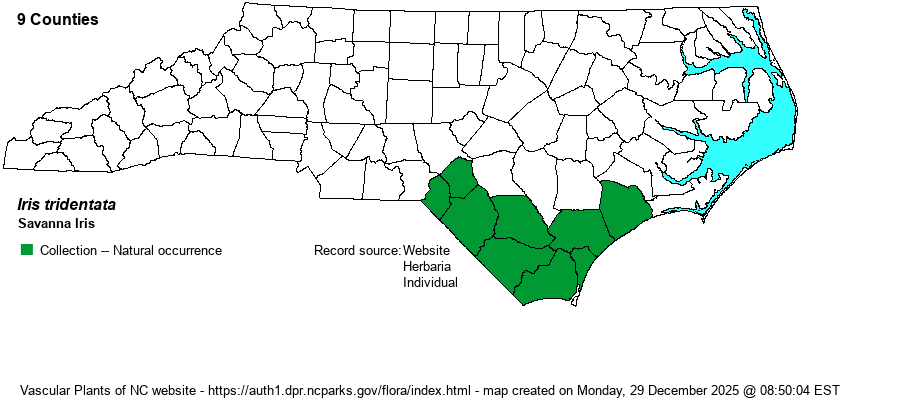| Author | Pursh | |
| Distribution | The southern part of the Coastal Plain, where specimens have been collected from all counties from Hoke and Onslow southward.
This species has a small range, being found in a tight and narrow zone from southern NC to extreme northern FL and coastal AL. Most occurrences are in the Carolinas. | |
| Abundance | Fairly common in the coastal counties, but less numerous northwestward, where it is generally uncommon to rare. The NC NHP's State Rank of S2S3 seems too conservative, as there are a large number of specimens for it and the species is not uncommon in some areas; this website recommends S3 for the State Rank. | |
| Habitat | This is a species of wet, acidic and sunny places. It favors wet pine savannas, but it can grow in wet pine flatwoods, margins of pools, margins of small Carolina bays, wet areas in powerline clearings, and even in wet scrapes. It is less of a marsh or ditch species than is I. virginica, where both grow in the same area. | |
| Phenology | Blooms from late May through June, and fruits from August to October. It usually blooms later than I. virginica in the same region. | |
| Identification | This is the shortest of the three "tall" native irises in the Coastal Plain, with a flowering stem generally about 1.5 feet tall. Its basal leaves are shorter, as well, mainly to about 1 foot long, but they are narrower than those of I. virginica, being less than 1/2-inch wide. The main separating character is the flower -- in this species the three petals are very short and barely observable, as they reach only to the end of the claw of the sepals. The sepals are quite large and showy, making each flower about 4 inches in width. Flowers tend to be a bit more violet in color than others, which lean toward blue. Though this species has lost populations in savannas due to habitat destruction, it still can be fairly easily seen in some savannas and in some Carolina bays. The blue-violet color of the flowers and the more flattened (horizontal) look of them should be easily noticed by observers. | |
| Taxonomic Comments | None
| |
| Other Common Name(s) | It is often named as Savannah Iris. Most biologists in NC recognize that the use of the word spelled as "Savannah" refers to the habitat or natural community, and not the Georgia city. Biologists spell the habitat as "savanna", and thus this website follows the biological spelling of the word that implies habitat. | |
| State Rank | S2S3 [S3] | |
| Global Rank | G3G4 | |
| State Status | | |
| US Status | | |
| USACE-agcp | OBL link |
| USACE-emp | OBL link |

